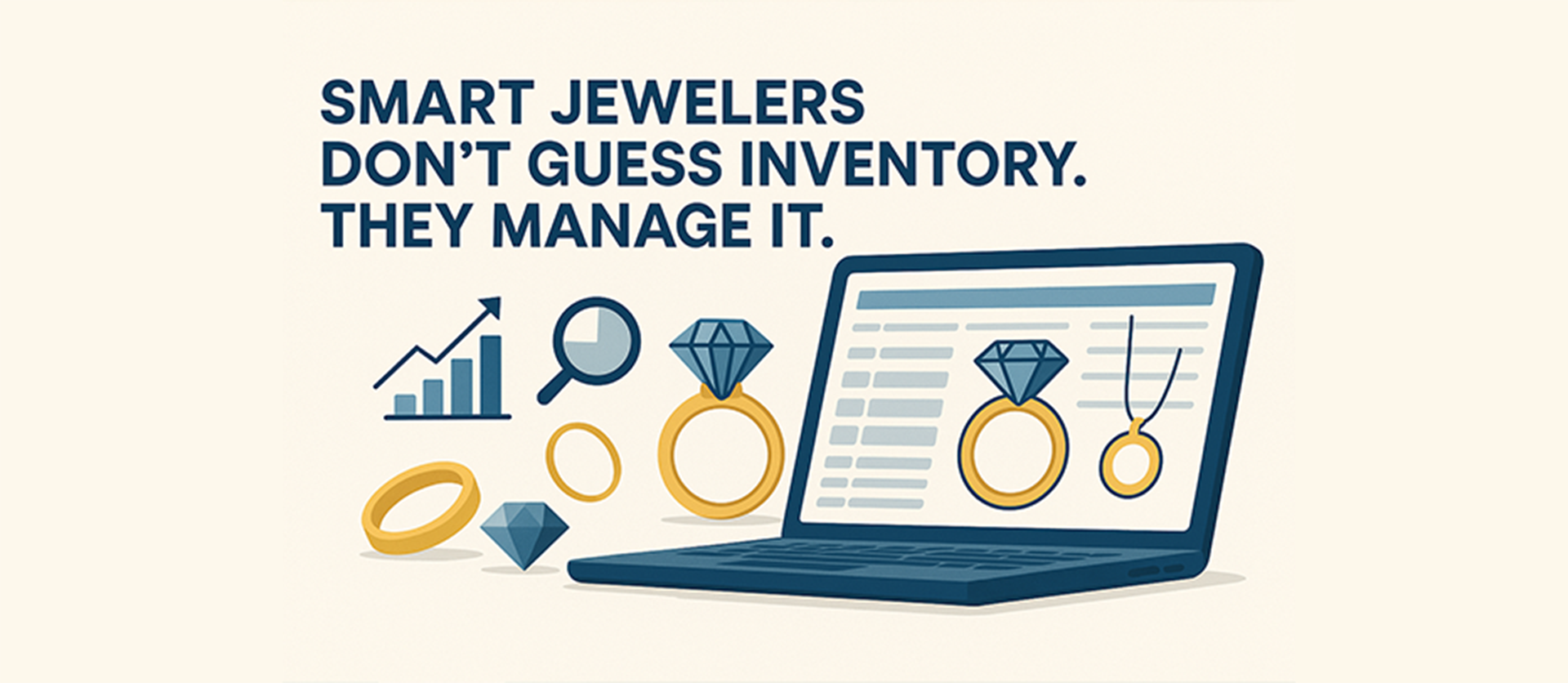

How to protect your profits and prevent stock-outs with the help of a jewelry software. Inventory issues are the silent profit killers in the jewelry business. From missing gold to out-of-stock bestsellers, poor stock management leads to lost revenue, customer frustration, and operational stress. And when your inventory consists of small, high-value items – diamonds, gold, precious pieces – the margin for error is
razor thin.
In this post, we’ll walk through best practices in jewelry inventory management and show how modern jewelry software can help you take control and protect your bottom line.
Why is inventory so difficult to manage in a jewelry business (and not Spreadsheets are the solution)
At first glance, inventory might seem like a simple matter of counting what you have and what you’ve sold. But for jewelry businesses, the reality is much more complex – and much more critical. Jewelry inventory combines high value, small volume, multiple units of measure, and channel complexity, making even small errors costly.
Let’s break down the core challenges – and explain why traditional tools like spreadsheets simply aren’t enough:
1. High-Value, Low-Volume Items = High Risk
A single item can be worth thousands of dollars – or more. Losing one small item, misplacing a diamond, or miscounting gold weight can result in major financial loss. Unlike bulk retail (e.g. apparel or electronics), every unit in a jewelry business matters.
In a spreadsheet-based system, one missed line item or a misplaced decimal point can mean a lost $2,500 ring – with no way to trace what happened.
2. Multiple Units of Measure (Weight, Quantity, Purity)
Jewelry inventory isn’t just about “how many pieces” you have. You need to track:
- Weight: grams, carats, ounces for gold, silver, and diamonds
- Quantity: pieces or units for finished jewelry or components
- Purity/Quality: karat, clarity, and certification for each material
Spreadsheets aren’t designed to handle layered inventory attributes. Trying to manage all this with formulas and manual tabs is not only time-consuming but highly error-prone.
3. Consignment vs Owned Inventory
Many jewelry businesses sell a mix of owned items and consigned inventory from suppliers. Mixing these in a single spreadsheet creates confusion:
- Who owns what?
- What’s your liability for losses?
- How do you account for revenue split?
Without dedicated fields and filters to separate consignment from owned stock, you risk accounting discrepancies, tax issues, or even legal complications. Spreadsheets aren’t built for this level of inventory categorization and tracking.
4. Omnichannel Complexity: Online + In-Store
Modern jewelers often sell through multiple channels — e-commerce platforms, physical stores, Instagram DMs, or tradeshows. Without a centralized system, this leads to:
- Double-selling: An item sold in-store appears available online
- Inventory mismatch: Manual updates lag behind real-world sales
- Unhappy customers: Due to delays, cancellations, or errors
Spreadsheets rely on manual updates, which can never keep pace with real-time omnichannel sales activity. The result? Chaos, missed revenue, and damage to your brand’s reputation.
5. Spreadsheets Are Prone to Human Error – and Don’t Scale
Let’s face it: spreadsheets were never meant to be inventory control systems. While they may seem simple and cheap at the start, they quickly become:
- Hard to manage as your business grows
- Full of formula errors, version conflicts, or accidental deletions
- Disconnected from real-time operations (like POS, manufacturing, e-commerce, or shipping)
As one business grows from a few SKUs to hundreds or thousands, spreadsheet complexity increases exponentially. What worked when you had 10 items will collapse under the weight of 500.
Even worse, there’s no built-in audit trail, no user permissions, no automation. That’s a big liability when dealing with high-value goods.
Best practices for jewelry inventory management
- Use Real-Time Inventory Updates
Prevents overselling, allows better purchasing decisions, supports omnichannel operations. - Track Raw Materials Accurately
Use separate SKUs for raw materials, semi-finished goods, and finished jewelry.
- Implement Barcode or RFID Tagging
Speeds up audits and reduces human error. - Set Reorder Points and Low-Stock Alerts
Automated alerts prevent stock-outs. - Separate Consignment from Owned Inventory
Track consignment items in a separate inventory class. - Conduct Regular Inventory Audits
Cycle counts help maintain accuracy and reveal shrinkage early.
How Software Brings These Practices to Life
Best practices are only effective when applied consistently, and that’s where jewelry ERP software makes the difference. Here’s what you gain with the right system: 
- Real-time inventory tracking from manufacturing to sale
- Barcode & tag support for speed and accuracy
- Multi-location inventory visibility
- Raw material tracking with weight, purity, and batch data
- Auto-alerts for low stock or fast movers
- Integration with e-commerce and POS to prevent stock misalignment
Fact: according to a FinancesOnline analysis, 96.6% of companies saw improved operating efficiency and 85.7% improved reporting and visibility after implementing an ERP system – with 82% achieving their ROI within the expected timeframe.
The Power of Traceability in Jewelry
 Today’s customers – and insurers – demand traceability. Jewelry ERP systems allow:
Today’s customers – and insurers – demand traceability. Jewelry ERP systems allow:
- Item-level tracking: Know where each piece came from, who processed it, and where it’s sold
- Batch-level accountability: Perfect for materials like melee diamonds or small findings
- Compliance readiness: Helps with insurance audits, customs declarations, and responsible sourcing
As Jobin & Jismi notes, full traceability from source to sale builds customer trust and helps prevent internal fraud.
Conclusion
Mismanaged inventory costs more than just money – it damages customer trust and slows growth. But with the right approach – and the right tools – your inventory can become an asset, not a liability.
- Track raw materials
- Prevent stock-outs
- Improve audit accuracy
- Scale with confidence
Ready to take control of your inventory?
Book a free demo and see how our jewelry ERP software can transform the way you manage your business.
FAQ: Jewelry Inventory Management
- Can jewelry inventory software – PIRO – track raw materials like gold or loose
diamonds?
Yes. PIRO let you track raw materials by weight (grams, carats) or quantity, with full vendor, batch, and wastage info. - How does PIRO inventory software prevent stock-outs?
By providing real-time stock levels, low-stock alerts, and reorder point automation. - What’s the best way to track consignment inventory?
Our system fully supports the management of both incoming and outgoing consignments (as some call it, memos). - Can I track items sold both online and in-store?
Yes. PIRO syncs inventory across all channels. You can see what you have available in your retail store as well as what has been sold online. PIRO Retail POS is linked to the same inventory database as your online store (e.g., Shopify). - Do I need barcode tags for jewelry inventory software to work?
Not necessarily, but barcode (or evenRFID) tags greatly improve accuracy and speed. In PIRO, we support both solutions.

Comments are closed